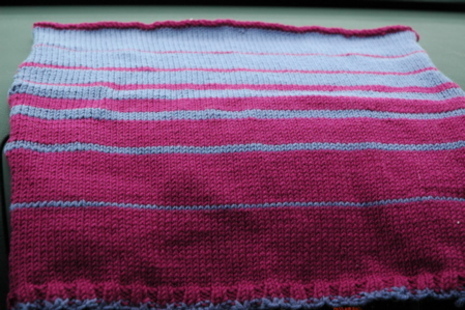(Image found on Stash, Knit, Repeat while looking at examples of Fibonacci in knitting)
If you’ve done any amount of knitting (or crocheting), you know math is involved. Whether it’s calculating your gauge, or so simple as counting your cast-on stitches (I go in multiples of 10- what about you?), you have to have at least a basic understanding of math.
However, some patterns take it beyond that. There’s Panta, which requires you measure the circumferance of your head and do a little math to discover how many inches each section will be (my Panta, for example, is a bit loose- my measurement and following calculations were slightly off). Or Numbers, which if you don’t go by the number utilized in the pattern (11) becomes a tricky thing of balancing out calculations based on whatever number you do choose (42, in my case).
One I found today is a d4 dice bag in which you have to do some math to figure out each of your triangles.
Today in my weekly “web diving” (every Thursday, before I go about my errands and chores, I spend a few hours simply browsing the web- usually researching one topic that caught my eye early on), I went into mathematical knitting. It fascinates me. And this time, it wasn’t in using calculations to decide your patterns. Well, not only that. The main thing that caught my attention was this:
0, 1, 1, 2, 3, 5, 8, 13, 21, 34, 55, 89, 144…
(Also, don’t you just love how the 12th number in the sequence is 12*12? I do.)
The Fibonacci sequence. We all know it. How many of us actually really think about it? It can be a very useful tool in knitting.
If you want to see some examples of the Fibonacci sequence in knitting:
Right now, I’m jotting down notes and designs for a scarf that utilizes the sequence on multiple levels. Is it nerdy of me? Oh yes. Is it going to look awesome when it’s done? You bet.
(I’m also resisting tearing out all the work done on my Essential Stripe sweater to use the sequence. Maybe when I finish this one, I’ll start another that uses it.)
However, numbers don’t have to factor into everything. In fact, we can see science at work in knitting in other fashions (though perhaps just visual in these cases):
- – Baby’s First DNA Model (If I had children, I’d be the kind of mom who’d make this sort of thing)
- – Double Helix Seaman Scarf (I love the idea, but the execution isn’t my cup of tea)
- – Binary Scarf (Imagine doing the Fibonacci sequence here!)
Want some tools to help in your mathematical knitting?
And, while it’s not entirely related to math, I leave you with this article: Real Men Knit
